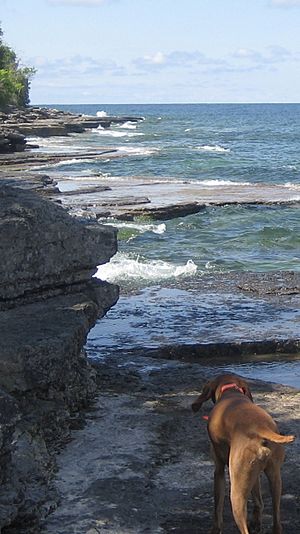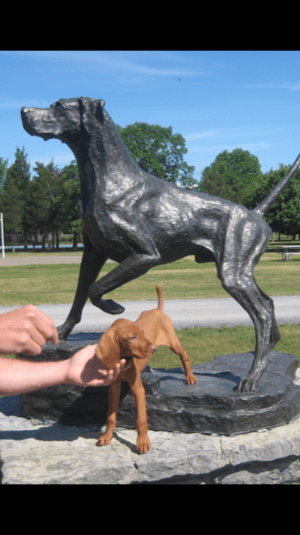Robert G. Wehle State Park facts for kids
Quick facts for kids Robert G. Wehle State Park |
|
|---|---|
| Lua error in Module:Location_map at line 420: attempt to index field 'wikibase' (a nil value). | |
| Type | State park |
| Location | 5182 State Park Road Henderson, New York |
| Nearest city | Watertown, New York |
| Area | 1,067 acres (4.32 km2) |
| Created | 2004 |
| Operated by | New York State Office of Parks, Recreation and Historic Preservation |
| Visitors | 75,842 (in 2014) |
| Open | All year |
| Website | Robert G. Wehle State Park |
Robert G. Wehle State Park is a huge park covering about 1,067 acres (4.32 km2). It sits right on the eastern shore of Lake Ontario in Henderson, Jefferson County, New York. It's a great place to explore nature and enjoy outdoor activities.
Contents
Park History: From Military to Nature Haven
Between 1895 and 1947, this land was used by the United States Armed Forces. It was known as the Stony Point Rifle Range. Soldiers from nearby bases like Madison Barracks and Fort Drum trained here. They practiced with rifles and even artillery. Sometimes, it was used as a temporary landing field for planes. You can still see signs of its military past in the park today.
In 1947, a car dealer named Thomas Nagle and a brewery owner named Louis A. Wehle bought the property. They turned it into a ranch for Hereford cattle. Louis Wehle's son, Robert G. Wehle, took over the property in 1968.
Robert G. Wehle: A Lover of Nature and Dogs
Robert G. Wehle was a big fan of nature and worked to protect it. He was also a talented sculptor. Most famously, he bred English pointer dogs and founded Elhew Kennels. He used the property as his summer home and a place for his dogs.
You can find several of Wehle's dog sculptures in the park. There are also old dog kennels and even a dog cemetery. Before he passed away in 2002, Robert Wehle made sure the land would become a park. The New York State Office of Parks, Recreation and Historic Preservation bought it for $2.8 million. The park officially opened to the public in 2004.
Exploring the Park: Fun Activities and Features
Robert G. Wehle State Park offers many ways to enjoy the outdoors.
Trails for Every Adventure
The park has trails for different activities. You can go hiking, mountain biking, or even cross-country skiing and snowshoeing in winter. Fishing is also allowed in certain areas.
Sports and Picnics
If you like sports, there are courts for tennis and volleyball. You can also find a nice picnic area with ten tables. This area is about 1.2 miles from the parking lot, so you'll need to walk to get there. It has an outdoor grill, a special composting toilet, and access to the beach.
Stay Awhile: Rental Homes
Some buildings in the park, including Robert Wehle's old summer home and art studio, can be rented for short stays. It's a unique way to experience the park!
Lake Ontario Shoreline
The park has about 17,000 feet (5,180 meters) of Lake Ontario shoreline. Some parts of the shore have amazing limestone cliffs that are up to 80 feet (24 meters) high.
Park Trails: Named After Pointers
There are thirteen trails in the park. Each one is named after one of Robert Wehle's famous Elhew Kennels pointer dogs.
Trail Details
The longest trail is Snakefoot Trail, at 4.9 miles (7.9 km). The shortest is Jubilee Trail, which is only 0.12 miles (0.19 km) long. All the trails are easy to walk, with very little change in height. They are also well-marked. Trail markers have different colors, a picture of a pointer dog, and the trail's name. Dogs are welcome on the trails and throughout the park, but they must be on a leash.
Here are the trails you can explore:
- Bobolink Trail - blue - 0.64 miles (1.03 km)
- Dancing Gypsy Trail - green - 1.87 miles (3.01 km)
- Huckleberry Trail - purple - 0.64 miles (1.03 km)
- Jubilee Trail - pink - 0.12 miles (0.19 km)
- Jungle Trail - brown - 0.86 miles (1.38 km)
- Kiwi Trail - dark pink - 0.42 miles (0.68 km)
- Knickerbocker Trail - black - 0.51 miles (0.82 km)
- Marksmen Trail - red - 1.4 miles (2.3 km)
- Midge Trail - dark green - 0.98 miles (1.58 km)
- Misty Trail - white - 0.32 miles (0.51 km)
- Snakefoot Trail - yellow - 4.9 miles (7.9 km)
- Tut Trail - light green - 0.32 miles (0.51 km)
- Zeus Trail - light blue - 0.51 miles (0.82 km)
Park Geology: Rocks and Cliffs
The rocks you see in the park are mostly from the Ordovician Period. This was a very long time ago! You can see different types of rock like dolomite and limestone along the shoreline. Other rocks found here include siltstones, sandstones, and shale. The Snakefoot trail is a great place to see the cool limestone shelves and tall limestone cliffs along the lake.
Park Flora: Plants and Invasive Species
The park is home to many plants. However, there's a plant called pale swallow-wort (Cynanchum rossicum) that is causing problems.
Understanding Invasive Plants
Pale swallow-wort is an invasive species. This means it's not native to the area and grows very quickly. It can take over the space and resources that native plants need to survive. The park actively mows this plant to try and stop it from spreading.
How You Can Help
Pale swallow-wort seeds can easily stick to shoes, clothes, and pet fur. To help protect the park, please check yourself and your pets for seeds before you leave. This helps prevent the plant from spreading to new places.



